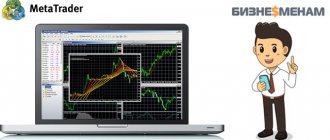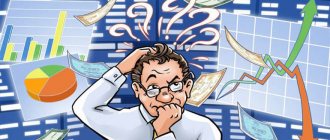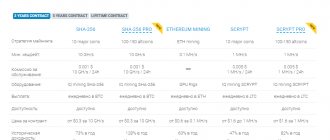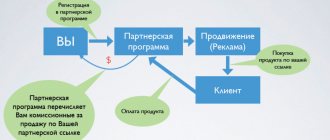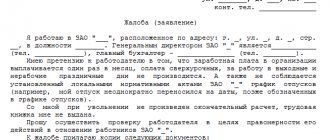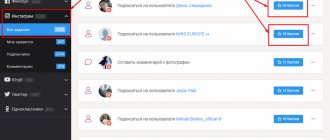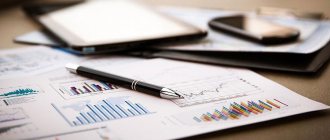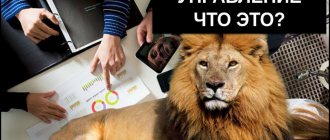What is trading in simple words
The concept of “trading” refers to the trading activities of legal entities and individuals associated with purchase/sale transactions of various financial assets in order to generate income. In fact, this is legal speculation on price differences.
Where do they sell?
Trading transactions are carried out on specialized financial platforms - exchanges (stock, commodity, cryptocurrency) and the over-the-counter Forex market. The assets used are currencies, stocks, indices, bonds, precious metals, cryptocurrency, oil, etc. Trading instruments can be options, futures, CFD contracts.
Profession trader: what is it?
Modern stock exchange players have acquired a new “image”: today it is a popular profession of a trader, which, thanks to the Internet, has a multi-million army in all corners of the globe. A trader’s professionalism directly affects the amount of his earnings, which is a powerful incentive to master all the nuances of speculative investing - buy cheaper and sell more expensive.
How traders work
A successful trader is, first of all, a competent trading analyst. He devotes the lion's share of his time to studying patterns of changes in market prices, using technical (graphical) and/or fundamental analysis.
The technical part, the operational component of trading, is carried out through authorized brokers (for Internet trading, trading terminals are provided that can be installed on a PC or portable mobile devices).
Required skills and knowledge
Trading, like any other professional activity, is based on special knowledge of the “subject” and practical trading skills.
The list of minimum requirements for trading includes:
- trader terminology;
- types and principles of operation of exchanges;
- functionality of trading terminals;
- basics of technical and fundamental analysis;
- building individual trading strategies;
- deal management tactics;
- rules of financial risk management.
In the CIS countries there are no universities where trading is studied as a specialty, so you have to acquire the necessary knowledge yourself (self-education or full-time/correspondence courses). It is best to practice the practical skills of a trader on a demo (training) account, which most brokers offer to open for free, without registration.
Who can become a trader
The numerical composition of the global trading community is the main proof of the accessibility of the trading profession to a wide range of people who want to show their abilities in a new trading field.
History knows many examples when traders without special education in economics, finance or mathematics gained worldwide fame.
The main criterion for assessing potential trading opportunities is not diplomas, but the presence of a certain set of personal qualities:
- logical thinking;
- introspection;
- penchant for innovative solutions;
- rejection of evaluation “stamps”;
- psychological stability.
The most famous traders in Russia and the world
The list of the world's top traders is headed by billionaire J. Soros, who regularly appears on the lists of the richest people on the planet. But he is not the only one included in a kind of “Hall of Fame” for traders.
Historical “contributions” to the theory and practice of stock trading were made by:
- C. Dow - The Dow theory is the basis of technical analysis. Invented the Dow Jones index.
- D. Livermore - gained fame during the Great Depression in the United States, managing to predict the collapse of markets and earn $100 million.
- J. Bollinger is an outstanding analyst, creator of the Bollinger Bands indicator. Came to stock trading after working as a television cameraman. For the first time I used neural network models in technical analysis.
- W. Gann is a developer of technical analysis tools based on the methods of geometry, astronomy, and astrology (angles and Gann grid).
- L. Williams is the first trader to introduce leverage into trading, the creator of a number of technical indicators, the absolute record holder of the world championship of traders Robbins World Cup (profit was 1100%).
- B. Williams is the author of a number of trading systems and indicators that are still popular today - “Alligator”, “Three Wise Men”, Fractals, etc. He became widely known after the publication of a series of books on the theory of trading chaos.
- S. Cohen - has achieved outstanding results as a hedge fund manager (personal wealth over $9 billion). Predicted the 2008 financial crisis.
- L. Raschke is one of the most famous female traders. Received recognition from the master of trading D. Schwager (review in the book “Market Wizards”). Author of a number of works on short-term strategies.
The short history of Russian traders cannot compete with the trading achievements of world-class luminaries, but talents are emerging:
- V. Safin is a practicing trader and author of a number of books on technical analysis.
- S. Bernukhov - successfully trades in markets with different types of assets and conducts teaching activities.
- A. Rezvyakov - specializes in trading futures on the RTS index, with an average annual income of 30%. In a record year, he managed to show a profit of 1427%.
Books that a novice trader should read
Books remain one of the main sources of knowledge on trading. Most publications by foreign authors have been translated into Russian.
A novice trader’s library cannot do without the classics:
- “Trader's Encyclopedia” by E. Nyman.
- “Technical Analysis” by D. Schwager.
- “Masters of the Market” and “Trading Chaos” by B. Williams.
- “Elliott Wave Principle” by A. Frost.
- “Japanese Candles” by S. Nison.
- “Fundamental Analysis” by L. Kolmykov.
- "Trading with Dr. Elder" by A. Elder.
- “Textbook on Day Trading” by L. Borsellino.
- “The Psychology of Trading” by B. Steenbarger.
- “Economic and financial risks” by A. Shapkin.
The books are available in electronic form (you can download them for free).
Why is trading needed?
If we talk about the trader’s personal goals, then this is, of course, making a profit.
He is not guided by any other aspects.
This job is no worse or better than others, only the amount of earnings here directly depends on personal skills and knowledge, and career leaps, as well as failures, occur much more often.
On a global scale, a trader is a person who directly influences the world economy; in this case, I’m talking about traders working for large banks and investment management funds.
The market operates according to the main rule: the greater the demand for a product, the higher its price. The same is true in reverse.
The international market determines not only the value of commodities or shares of large companies, but also currencies.
The more attractive a country’s economy is, the more investment the state will attract into it and the higher the value of its currency.
The main market makers, that is, those who set prices and influence their exchange rates, are the central banks of different countries.
By injecting or withdrawing huge amounts, they can lower or raise the price of a currency.
Ordinary, private traders, of course, do not have such influence, but in the aggregate, their actions also affect the economy.
Types of trading
There are several types of trading depending on the methods of analysis, the assets used and the methods of trading.
Financial
The concept of financial trading can include all types of operations on financial platforms; if we distinguish it as a type, then it is customary to talk about trading assets of stock exchanges (stocks, indices, bonds). The main trading participants are large investors, corporations, and financial holdings.
The algorithm for algorithmic trading was given in the USA when the Securities Commission allowed stock exchange trading on electronic platforms (1998). Thanks to the innovation, the execution time of transactions has been significantly reduced (down to microseconds). Stock traders who began to use the new technique began to be called quantum traders.
Algorithmic trading is based on an automated trading method, where mechanical or automatic trading systems are responsible for executing trades. A special feature of the ATS is the complete elimination of subjective market assessment - all decisions are made by a “robot”. In MTS, a trader can interfere with the work, taking over some of the functions of the trading system.
When developing algorithmic trading systems, historical quotes of an asset or combined data for several instruments are taken into account. The main task of the creators of “robot advisors” is the ability of their “brainchild” to control the algorithm for opening/closing positions, taking into account changing market trends.
To independently develop a profitable trading “robot”, a trader will need special knowledge in programming, but you can also use a ready-made “product” by choosing an assistant for strategic trading priorities (trend trends, scalping, Martingale, etc.).
Internet trading
Trading via the Internet occupies the main segment of the financial services market. For example, the over-the-counter Forex market, operating exclusively via the Internet, has surpassed in liquidity all the classic exchanges of the world combined.
To take part in the auction, you must:
- choose a broker providing online trading services;
- register with him;
- install the trading terminal on your PC (you can use a smartphone or tablet);
- open an account and top up your deposit (there are micro and cent accounts for Forex trading).
To master the first steps in trading, brokers offer beginners the opportunity to work on a demo account, as well as take a training course (usually free of charge).
Successful trading in the stock market. From zero to the first million. Textbook
Author: Mikhnov D.
Number of pages - 322. Publisher: Prime-Euroznak, 2016
This book provides information in simple and understandable language about how the exchange works and how the futures and stock markets differ from the Forex market, as well as why it is worth trading stocks or futures. The author did not ignore such topics as regulation and tax legislation, which are directly related to trade.
The book explains in great detail the process of making trades and opening positions using images and step-by-step instructions. In addition, the topic of technical analysis and trading psychology is touched upon.
Quote: “In order to start trading futures contracts, you need to open an account with a broker (the intermediary between you and the exchange) and place on it the amount you estimate is necessary for trading. This amount will be a kind of “insurance” for the exchange in case the contracts you bought have decreased in price. All profits from your trading will be credited to this account, and all losses will be debited from it.”
book “Successful trading in the stock market. From zero to the first million. Textbook"
Features of online trading
Online trading allows you to use almost all exchange trading tools - select any financial assets, analyze the market situation based on historical and current quotes, use margin trading, replenish your deposit and withdraw profits, use manual and automated trading methods, and use the advice of professional traders.
A prerequisite is the presence of a stable Internet connection and an agreement with a broker.
Advantages and disadvantages
According to statistics, 95% of traders work remotely from the main exchange platforms, which proves the global trend in favor of online trading via the Internet. Comfortable conditions (the trader himself chooses the place and time to work), the ability to choose a financial platform and broker (you can work with several at the same time), minimal costs for technical equipment - these are the factors that determine the positive attitude of Internet traders.
In contrast to the obvious advantages, we should not forget about the potential threats of online trading:
- high risks of trading with leverage;
- poor quality internet broker service;
- imperfect legislation in the field of protecting the rights of traders.
Types of software for online trading
A variety of software has become an integral part of effective online trading. The software is used to create trading terminals, strategy testers and templates, and robot advisors.
Software for beginners
Novice traders, due to lack of knowledge and experience, prefer to use automated systems as much as possible. Their arsenal of trading methods is dominated by robot advisors, ready-made strategy templates and programs for receiving trading signals, and the popular MetaTrader 4 as a trading platform.
Rice. MetaTrader 4 terminal window
The trading process is helped by mastering training programs that are equipped with functionality with examples of transactions, terminology, principles of operation of exchanges, and other introductory materials.
Software for professionals
Programs for professional traders are aimed at deep analysis of the market using methods of fractals, clusters, quanta, volumes, etc. ATS and strategy testers are used as auxiliary tools in the preparation of individual trading tactics.
Examples of software for professional trading include the platforms ATAS (Order Flow Trading company), SaxoTraderGo (broker Saxo Bank) and trading engines, for example, QScalp for high-frequency trading in short-term strategies.
Rice. SaxoTraderGo terminal window
Automated trading software
Programs for automatic trading are used in all types of markets (stock, Forex, cryptocurrency) and occupy more than 70% of all transactions. Such software may be based on analytics based on technical or fundamental data.
Automated trading software features include:
- market analysis according to the conditions of the features and trading strategy used;
- automatic opening/closing of transactions, with placement of stop orders according to specified conditions;
- risk management - limiting the number and volume of transactions in the event of unfavorable price movements.
To create a mechanical trading system yourself, you can use a special terminal TSLab (trading systems laboratory), which allows you to develop, test and optimize trading robots even without knowledge of programming basics.
Main advantages of TSLab:
- an interface that allows you to compose a script using ready-made blocks;
- Russian-speaking technical support;
- the ability to use robots on different trading terminals;
- built-in risk module that insures against high risks (transactions at inadequate prices, an excessively large number of open positions for one asset) and technical failures.
It should be understood that there is no perfect software for automatic trading - market conditions are constantly changing and require regular adjustments in the algorithms that were originally included in the program.
What is the best way to trade for a novice trader?
Now Forex brokers within one trading platform provide a large selection of financial instruments: currency pairs, CFD contracts for shares, futures, cryptocurrencies, raw materials (oil, gold, silver, etc.). It’s easy for a beginner to get lost in this diversity.
To make your choice easier, study separately the features of different types of markets.
- The foreign exchange market is good for those who want to trade at any time of the day. It has high volatility, which allows, with the right approach, to earn money faster. For a beginner, it is better to start by choosing the main currency pairs (with the dollar), as they are more understandable and less volatile. Cross rates are characterized by high volatility, and exotic pairs have low liquidity, so it is better to postpone trading them until your experience in the market grows.
- The stock market allows you to make good money, but the movements here are more restrained, since one trading session (unlike the foreign exchange market) does not last around the clock. It is suitable for those who want to trade calmly and get stable profits.
- The commodity market (oil and gold are the most popular among Forex traders) is suitable for diversifying your trading portfolio. But due to the high volatility of gold, it is better to work with it if you have a large trading account.
- Cryptocurrencies can be chosen for diversification after you have learned to understand the market as a whole and have mastered the technical analysis of cryptocurrencies.
What is social trading
Social trading is included in the “package” of options that make life easier for a novice trader. In essence, we are talking about one of the forms of trading - passive trading, where clients are offered the opportunity to use the experience of professionals to make one or another trading decision by copying transactions.
Unlike ATS, the role of advisor is performed by real traders who not only recommend, but also participate in the trading process. Naturally, this format of cooperation has a high degree of trust among users of “tips.”
Social trading scheme
The social trading service operates according to a simple scheme: a trader selects a “leader” (it is possible to analyze his activities over a long-term period) and subscribes to copying his transactions (a paid service).
Then everything happens automatically - the system connects your account to the trading platform, transactions will be opened in compliance with all parameters - asset, lot size (scaled to the trader’s deposit), stop order levels.
Social trading services can be used to trade on any financial markets.
Top best platforms for social trading
The social trading service is not available from all brokers, so the service has been developed on specialized platforms (you must register to receive the service).
In the ranking of the best:
- Zulu Trade is one of the world's largest platforms. Works simultaneously with several brokers, offers interactive communication between traders through social networks.
- eToro is a broker with a developed social trading network. In demand among beginners, because... offers a number of training programs, a fully functional demo account and a user-friendly terminal interface.
- Tradeo is a specialized social network for traders. Has the function of simulating transaction copying.
- Who Traders - the platform from FINAM offers social trading using a variety of assets, incl. leading US exchanges. Registration cost is $10, subscription to connect to the accounts of 10 traders is $50. Unites more than 1 million clients.
- ATON Space is a platform for “moneybag” traders (access with a minimum deposit of $100 thousand).
Advantages and disadvantages
Social trading will be an excellent assistant for new traders, because... does not require immersion in analytical market research, provides invaluable practical experience, and minimizes risks. The price of the service is comparable to the broker's commission.
There is also a flip side to the trading “coin” - the effect of getting used to ready-made trading solutions slows down the formation of an independent trader.
Trader's tutorial. Psychology, technique, tactics and strategy
Author: Steenbarger B.
Number of pages - 330. Publisher: Alpina Publisher, 2016
Brett Steenbarger's books are bestsellers, since the author is not only a trader, but also a psychologist who also runs his own blog dedicated to the psychology of trading.
Although this book cannot be called a practical guide, it will most likely help many people start trading in financial markets.
At the heart of the book, as in other books by the author, the emphasis is on the psychology of trading. The reader will be able to learn how to choose the right type of trading for themselves and how to cope with psychological pressure during times of increased volatility in the market.
The book reveals the psychological aspect as much as possible and says very little about trading itself in technical terms, so if a trader or investor has already mastered some trading skills, this book will be a very useful addition, as it contains a lot of psychological advice.
Quote: “Traders without experience in various fields are somewhat like partners in a marriage of convenience. Perhaps the marriage will be successful; perhaps it will end in disaster. But in any case, the spouses are unlikely to experience pleasure. How many traders never reach the stage of mastery, not because they are lazy, but because they simply did not do their job?
book “Trader's Self-Instruction Manual. Psychology, technique, tactics and strategy"
Ways to gain trading knowledge for a beginner
The pilgrimage to the online trading market has also forced the market for services aimed at serving a rapidly growing clientele to become more active. One of the most popular trading segments has become the education sector.
Newbie traders who got burned while trying to conquer Forex and other exchanges without appropriate preparation, but did not give up, made the only correct conclusion - they need to “arm themselves” with knowledge.
The first to respond to the request were brokers who were not going to lose clients. A “trading training” section was promptly included in the set of trading conditions, and in most companies the basic course is offered free of charge (at the request of clients, various forms of classes can be selected).
Self-study of trading basics
Mastering the intricacies of trading is not an easy task, but it is not at the level of mandatory lectures from professors - this is confirmed by the experience of successful stock exchange players who do not have diplomas in the trader specialty.
Independent training of a trader may well compete in effectiveness with training “under the supervision” of professionals for two main reasons:
- On the Internet you can find enough information on the “material parts” of the item.
- The role of teachers is most often played by theoretical traders who have never risked their money and are unable to convey to students the state of “market nerve” - a feeling without which one can only trade on a demo account with virtual money.
Online training
This type of training is offered in the form of webinars and video courses on trading, and has its advantages:
- There is no need to waste time traveling to the place of classes.
- The training program is systematized.
- It is possible to work in the form of “questions and answers”.
Attending in-person classes
Hospitality lovers will have to look for specialized trading courses, because... brokers rarely have their own representative offices and organize on-site training. In Russia, only some bank brokers provide such training.
Full-time training is often aimed at an advanced contingent of traders, where tasks from the “highest aerobatics” of trading are considered, and classes are taught by practicing traders with a name, sometimes even worldwide.
How to complete trading training for beginners: step-by-step instructions
Beginning traders should not try to immediately “take the bull by the horns” - this applies to both trading and the learning process. The best option is a “step by step” tactic.
Choosing a learning method
Of the training options listed above, you can choose any one or even combine several if you have the desire and opportunity. The only “hard” connection is the mandatory study of the basic trading school.
Mastering the market and the main concepts of stock trading
A trader needs to start with the basics:
- Master the trader’s “primer book” - terminology, without which further training is impossible (for a beginner, such concepts as swap, margin call, take profit, gap, trailing stop, ECN account, etc. are a secret “closed seal”) .
- Understand the types and mechanisms of functioning of the main financial platforms - who, where, when and what trades.
Studying the trading terminal
The trading terminal is the main tool for conducting operational activities, so a trader must thoroughly master all its functionality and be able to quickly carry out the necessary manipulations (sometimes the issue of making a profit/loss is resolved in a few seconds). Practical skills are acquired on a training account.
Brokers’ trading conditions must contain information about the type of platform offered, which will allow you to first familiarize yourself with its capabilities and determine whether it is suitable for you (beginners are not recommended to use “overloaded” terminals and opt for the universal options of MetaTrader - version 4 or 5).
Learning the basics of risk management
Issues related to risk minimization are united by the concept of “money management trading” and are included in the group of knowledge on which the outcome of not only a specific transaction, but also the entire deposit depends.
Common truths, ignoring which leads to fatal losses:
- excessively high lot size;
- opening many orders simultaneously for different types of assets;
- trades without setting a stop loss;
- attempts to hold unprofitable positions in anticipation of a price reversal.
The basic rule of trading is that the total size of open transactions should not exceed 2–5% of the total deposit amount.
Introduction to the basics of fundamental analysis
Common types of analytical studies of market fluctuations are fundamental and technical analysis. Despite the ongoing debate about their priority, a trader should master both.
Fundamental analysis is based on data from economic indicators (published in the economic calendar on brokers’ websites). Relevant for traders working on stock exchanges (in Forex it is more often used for forecasting long-term strategies).
Study of technical analysis
Technical analysis is based on the study of graphical trading models, which include market research methods using various indicators and patterns (figures). The tools used are the set that is equipped with the trading terminal.
Opening a demo account and applying the acquired knowledge in practice
A training account (demo) allows new traders to acquire practical trading skills and test individual trading strategies. Work on a “demo” can be carried out in parallel with trading on a real account, without which it is impossible to learn how to manage emotions and risks (responsibility for the loss of a virtual and real deposit are two big differences).
Analytics Basics
Over the many years of the existence of financial markets, many attempts have been made to reduce price movements to some general rule. Today there are two directions that can be used. You can also successfully combine them. This is technical analysis and fundamental .
Technical analysis is based on the assertion that all the information a trader needs is already contained in the charts, and this is enough to make the right decision on the future direction of the price.
Fundamental analysis involves tracking external factors to which the market usually reacts immediately. These could be political events, economic changes, natural disasters, etc. There are a number of economic indicators that can be used to predict small price changes with great accuracy. Forex quotes are closely related to the price of oil.
For traders choosing technical analysis, it is better to take chart time periods of no more than 1 day. With the fundamental it is different. Here, on the contrary, one day is the minimum time frame. The exception is trading on news.
Main types of technical analysis
Technical analysis can be very different. You can use one or more approaches to forecast prices:
Graphical analysis. Considered a classic option. It is also the oldest of the existing ones, if you don’t count Japanese candlestick analysis, which has long been unknown in the West. It is carried out using graphical tools, by building trends and channels, and searching for figures. This also includes trading using Fibonacci levels.
Indicator. It is built on the basis of mathematical calculations translated into certain formulas. Today, calculations are made by computer programs called indicators.
Wave analysis. It is carried out on the basis of the Elliott wave theory.
Candlestick. Japanese candlesticks are used as a basis, which is one of the charting methods. It is considered very effective, but is rarely used due to the fact that it requires more in-depth study than, for example, the popular indicator.
Where to start as a trader
When deciding to start trading, you need to decide on several key points that are associated with choosing a broker.
Firstly, on what platform and what assets to trade. For example, if the choice fell on binary options, then you should select a brokerage company that specializes in this instrument.
Secondly, acceptable trading conditions.
Here it is important for a trader to consider:
- minimum deposit size;
- leverage range;
- type of trading terminal;
- size and type of spread;
- volume and “step” of the minimum lot;
- set of available financial assets;
- order execution speed;
- the ability to use automated trading;
- conditions for depositing/withdrawing funds.
Choosing a broker
The class of a brokerage company will become one of the determining factors in the effectiveness of trading. Competition in the brokerage services market is very high, but this factor does not always influence the quality of service. Information about unscrupulous brokers regularly appears on trader forums, which makes you think about the criteria that a reliable partner must meet.
Guidelines for choosing can be:
- length of service of the company;
- availability of a license from a well-known financial regulator (for example, the British FCA, the German BaFin, the American SEC). In the Russian market, control is exercised by the Central Bank and the Center for Financial Markets, which issues a certificate to members of this organization;
- presence of representative offices in the country where services are provided;
- customer service adapted to local conditions (multilingual website, technical support);
- rating published on independent resources;
- traders' reviews.
Rating of the best brokers for new traders
More than 200 brokers work on the Russian Internet trading market. Many have 10 or more years of experience, licenses from respected regulators and positive customer reviews.
The top list, according to estimates from various specialized resources, includes:
- Alpari. 20 years in the online trading market, min. unlimited deposit, MetaTrader trading platforms, leverage up to 1:1000, more than 100 trading instruments. FCA regulator.
- Forex4You. Operating since 2007, min. unlimited deposit, leverage up to 1:1000, spreads from 0.1%, trading platforms MetaTrader, Web Trader, financial assets - currency pairs, shares, cryptocurrency. FSCM regulator.
- AMarkets. More than 10 years of experience, leverage up to 1:500, MT4 trading platform (there is an application for portable devices), financial instruments - currency pairs, precious metals, shares, CFD contracts. FCA regulator, MiFID member.
- InstaForex. Registration in 2007, min. deposit - $1, leverage up to 1:1000, market spreads from 0%, MT4 trading platform, wide range of financial. assets for trading.
Opening a trading account
When a partner broker has been identified, you can proceed to the registration procedure and opening a trading account.
On the company’s official website you need to fill out a form asking you to indicate:
- surname, first name;
- passport details;
- year of birth;
- residential address;
- citizenship;
- phone, email mail.
Gaining access to start trading
After processing the data, the broker sends an email. email a link to activate your account, which opens access to the trader’s personal account. Some brokers ask you to go through a verification procedure - you need to send a scan of your identification document.
Having agreed on the formalities and signed a brokerage agreement (can be done electronically), the trader has the opportunity to register the selected trading account, replenish the deposit and start trading.
Download and install special software
All operational activities are carried out using a trading terminal provided by the broker. Its installation is extremely simplified and takes a few minutes (does not require additional software). You can download the trading terminal using the link on the broker’s website (most terminals have applications for installation on mobile devices running Android and iOS).
To form individual strategies, you may need tools that are not included in the basic equipment of the terminal (for example, proprietary indicators, templates and strategy testers, trading robots). In such cases, additional software tools are used.
Analysis of information about exchange rate dynamics
The trading terminal allows you to analyze the market situation, thanks to the flow of price quotes that are reflected online. The forecast can be built using graphical research methods - using indicators, levels, channels, trend lines, patterns, as well as based on information about changes in economic indicators - fundamental analysis.
Generating a request to open a deal
Positions are activated based on trading signals, the truth of which is determined by one or more analytical methods. Professional traders are guided by data obtained as a result of complex analysis - the generalized values of technical and fundamental analysis are taken into account.
Fixing the financial result of the transaction
Closing a profitable or unprofitable position can be done manually or automatically (if stop orders are set - take profit, stop loss). When for some reason it is not possible to manage a transaction through a trading terminal, the trader can give the appropriate order to the broker by phone (a mandatory option that must be specified in the contract).
How to start trading on the stock exchange. Instructions for beginner traders
If you decide to start investing, imagine that you are going on a long car trip. And before you get behind the wheel, there are a number of important things you should consider.
- Where are you going? What are your financial goals?
— How long do you expect to be on the road? What is your investment horizon? Do you want profit tomorrow or are you willing to wait a few years?
— What should you take with you on a trip? What would you like to invest in?
— How much gasoline should be poured into the tank? How much money can you allocate now and in the future to achieve your goals?
— Will there be an intermediate stop? Do you have short-term financial needs?
— How long do you plan to stay at your destination? Will it be necessary to live only on investments in subsequent years or will there be additional income?
Until you have given yourself clear answers to these questions, you should not leave home. The probability of getting there, of course, remains, but the risk of getting stuck somewhere along the way is growing.
Similarly, investing does not tolerate negligence in planning. Accurate numbers in your initial plan are the key to a meaningful path later.
Like almost any long-term journey, investment requires initial capital. And there are several important points here. First, you should invest only a very small portion of your available cash in the stock market (for example, 20% of your savings). Secondly, there can be no question of “borrowing from friends, taking a loan from a bank, quickly earning 50% per annum on the market and being happy.” You cannot trade with borrowed money! Because risks are present in any case, and if you are weighed down by the need to return the initial capital to creditors, this will lead to psychological discomfort and a number of mistakes. Only for your own and only for a small part of your savings.
Step one. Education
Of course, it’s difficult to drive a car if you don’t know the rules of the road and it’s your first time behind the wheel. Therefore, we recommend starting with training. To get started, read any book on stock trading. Of course, you will not learn to trade from one book - no matter how brilliant it is - just as you will not learn to write poetry by reading the colorful and understandable Primer.
For our part, we can offer a large number of educational materials on a variety of topics in the training of our website. We can also offer beginners brief instructions on which topics are best to start mastering the investment craft. To do this, you can read the special review I am new to the stock market. Where to begin.
In addition to educational materials, if you wish, you can find a whole range of courses on the stock market for beginners. The beauty of technology is that today you don’t have to rush after work every day to attend evening in-person classes - you can take training online, often even for free. Here you can learn more about the different types of stock market trading training.
Step two. Opening a demo account
As part of your first steps in the market, we recommend that you do not neglect demo trading. Even if the funds allow you to spend a significant amount on gaining experience and testing various strategies, there are a number of nuances that do not require material costs.
At a minimum, as part of educational trading, you will be able to study the trading terminal, see real orders, “get your teeth into”, and correct minor technical errors when testing trading ideas. And all this without risk and absolutely free.
Step three: Choose a broker and open a real account
Any time you feel you are ready for the real market, simply open an account with the broker of your choice, deposit money and start trading. However, do not rush to deposit the entire available amount: there is one important point that is often ignored and then paid dearly by beginners - psychology. It is this that often becomes a stumbling block for inexperienced investors. Just believe me: trading with real money is fundamentally different from trading with candy wrappers. You will inevitably encounter a number of psychological traps that will interfere with the implementation of your trading plans. To understand and overcome all psychological barriers, it is very wise to invest real money at the initial stage, but in small amounts. Even small losses will give you an idea of what trading psychology is all about. In doing so, you will learn valuable lessons with virtually no threat to your account.
You can learn more about psychology in trading from the materials in the collection The Best Materials on Psychology
One of the most important steps is choosing a broker. Just as the choice of a car for a long trip affects the final success of the event, the choice of a broker determines the range of your options in the investment process. Choose according to parameters that you understand: ease of opening an account, commission size, initial investment amount, trading platforms, etc.
For example, BCS Broker offers novice traders the “BCS-Start” , which allows you to test various company services and get acquainted with the advantages of the stock market. The tariff, for example, includes reduced commissions for the first 30 calendar days, as well as the possibility of personal consultations with the company’s stock trainers.
Opening an account today is very easy. As a rule, you don’t even need to visit the offices of brokerage companies to do this. A number of them offer to open an account online by simply attaching copies of the required documents to the application. Carefully study the relevant section on the website of the selected broker or contact by phone/Skype, etc.
When the account is opened, you need to decide on the software. Various companies offer their terminals for trading on the market. The most popular and functional program for working on the stock market is QUIK. There are versions of this program not only for a personal computer, but also for the web, and even iQUIK for iPhone and iPad. In any case, the broker you choose will be able to recommend a particular platform and even teach you how to use it.
Step four: Choose your strategy
At the beginning of the text, we planned a trip by car. However, it is never too late to change your mind and get to your desired destination by public transport - bus, plane, etc. You just need to buy a ticket. When it comes to investments, you can also refuse to manage your money yourself - just get on a bus like this (buy, for example, a mutual fund) and relax and watch out the window, waiting for them to take you to financial independence. The path can be winding, long, with a number of stops, and all decisions are made by the driver (manager). When you are driving a car, only you watch the road and choose the route, i.e. those financial instruments that will help you earn money, and the strategy for working with them.
As part of this approach, since 2020, BCS has been offering investors a unique innovative product - trading recommendations based on data from artificial intelligence, which are analyzed using a special software package Risk Assessment Innovative System (RAIS). To gain access to one of the most modern investment instruments, you need to connect to a special Artificial Intelligence tariff.
If you are more interested in independent trading, then at the initial stage you must decide whether you will be an investor or a speculator , which stocks you will include in your investment portfolio, and also which trading system you will adhere to. The fact is that in order to consistently make a profit from trading in financial markets, one must strictly adhere to certain rules that the investor himself determines for himself through experience. A set of such rules that determine the moment of entry and exit from the market, the volume of investments and the choice of financial instrument is called a trading system. Read more about this in a special material.
Over time, you yourself will probably understand what you are missing in working on the stock exchange. Perhaps you need expert help (a broker can provide trading recommendations, in addition, there are a number of communities where you can communicate with traders and get advice ), or serious analytics, or you are thinking about algorithmic trading (with the help of robots), or additional training.
Remember just one important point: almost anyone can make money in the stock market. Just remember Richard Denis, who in the second half of the last century made a bet with his friend, recruited 23 people from the street, gave them money and taught them how to trade. And these 23 people, later called "turtles", earned millions of dollars for him and themselves.
BCS Broker
Trading Strategies
The effectiveness of trading is determined by the choice of the optimal trading strategy, which depends on:
- deposit size;
- trader skill level;
- time devoted to trading (main job, additional income and other factors).
Scalping
A favorite trading strategy for novice traders that gives quick results. It is based on high-frequency trading - opening a large number of transactions in short time intervals. Profit goals are limited to a few points in the hope of accumulating a decent positive balance due to the number of transactions.
Trading is carried out on TF M1, M5, with any financial assets (preferably with high volatility). Scalping uses a variety of forecasting tools, primarily technical ones.
The main disadvantages of this trading trading strategy are the high emotional load and a large number of false signals caused by “market noise” on small time frames.
Intraday
Intraday trading can be a variant of scalping or a more cautious approach in which one or two trades are opened during two trading sessions (European and American). Compared to “pure” scalping, intraday trading is distinguished by a more balanced approach to analytics, lower risks and uncritical psychological pressure.
Intraday strategies allow a trader to work with a small deposit and focus on several proven patterns of price movement - opening/closing of a trading session, changes in volatility for specific assets.
Medium term
Medium-term trading is designed for time intervals from several days to several months and is considered the “golden mean”, because free from the disadvantages of short-term strategies and uses the advantages of long-term ones:
- the main TF for analytics is H1 (does not “suffer” from inexplicable price jumps);
- any financial assets (without reference to the level of volatility);
- a large selection of forecasting methods;
- profit goals of 100 points or more.
Long term
Long-term trading is more like investing than speculative operations:
- trading takes place on large TFs - from H4 and above;
- trend and channel strategies are used;
- profit goals reach several thousand points.
A prerequisite is the presence of a sufficiently large deposit that is able to “reflect” the threat of significant corrections.
Prop trading
This type of trading involves trading carried out by financial companies exclusively at their own expense. The income part is formed by profits from transactions (no commissions or other sources of earnings). Stocks, currencies, bonds and derivatives on them are used as trading assets.
A trader who trades for a prop company uses its financial capabilities and shares the earnings. The amount of a trader’s income (pay-out) depends on the results of his trading and personal financial participation (can range from 10 to 95%).
Technical
Technical trading is based on assessing the market using graphical analysis - indicators and non-indicator methods, for example, Price Action (pattern forecast). Technical analysis is indispensable for short-term strategies, when price fluctuations have virtually no correlation with macroeconomic indicators.
Fundamental
For traders working in the stock market and preferring long-term planning, it becomes mandatory to study the basics of fundamental analysis, which is based on market patterns based on economic and political characteristics that can affect market conditions:
- GDP data;
- inflation indicators;
- unemployment rate;
- changes in Central Bank interest rates;
- elections of presidents and parliament.
Swing trading - swing trading
Swing trading tactics are based on the characteristics of price behavior along a trend and can be used by traders who are proficient in wave analysis. The calculation is made to open a trade in the direction of the trend when the correctional wave ends.
It is recommended to trade on medium-term TFs and be sure to duplicate the trading signal with several analytical tools, for example, rely on current support/resistance levels.
Moment
The essence of this trading method of trading lies in the name - to use the moment (it’s difficult to call it a strategy, rather a tactic). A trader looks for profitable trading signals for an asset using different timeframes. If such are identified, then transactions are opened at once on all time intervals. In fact, all types of trading can be used - from scalping to long-term trading.
Stages of growth at the beginning of a trading career
There are many tips on how to trade better. But it is much more important to do the right things.
First stage: choosing a broker
There are many criteria for choosing the right broker. One of the most important is the presence of a license. You also need to pay attention to the trading conditions: what is the minimum lot, is the spread too high, are there all the instruments you are going to trade.
You can choose a broker from our section Top Brokers - 2017. The most worthy, in our opinion, companies are presented there, the integrity of which we have personally verified.
Stage two: training to use the platform
If your broker does not provide instructions on how to install and download the terminal, as well as how to work with it, you can find out about this in detail on our website. For example, in this article. It is important to learn many little things right away: such as one-click trading, working with indicators, news and analysis tools, and some others.
Today, one of the best companies that provides maximum knowledge and information to its clients is Alpari.
Download Metatrader 4 from the official website:
Third stage: learning to trade
Training should be not just a set of knowledge, but also its mandatory application in practice. But the idea that you need to study Forex for years before you start trading is completely wrong.
2-3 hours of training a day is enough, including practice, and in a couple of months you will have a good understanding of the basics. This is enough to get started. Also in the future you will need to supplement your knowledge and improve it.
Stage four: opening and funding a real account
At the learning stage, it is better to use only a demo account. Next you will need to open the real one.
A big misconception is the idea that you need to top up your account with the amount of the minimum deposit. Sometimes such a decision can be a failure. It is best to base your stop loss on the level you plan to set. Correct capital distribution implies that it should not exceed 2% of the total deposit.
This means that if you plan to set an average stop loss of, for example, 50 pips, and the pip in your trades will be equal to $1, then $50 should equal two percent of the total deposit. Then you need to top up your account with $2,500.
There are other rules of money management that must be followed. But this is one of the most reliable for calculating the deposit amount.
Fifth stage: choosing a strategy
The strategy must meet the main requirement: the total number of profitable transactions is greater than unprofitable ones, and in general it brings profit. With the right choice, further success depends entirely on you.
You can find a good strategy on our website. We offer a considerable number of options, regardless of which instrument or timeframe you choose.
How to make money from trading: expert advice
The primary task of a novice trader is not to “lose your deposit.” If this stage is completed successfully, then you can think about making money.
Pros recommend focusing on the following “pillars” of trading:
- Don't trade without a strategy.
- Do not rush to increase the volume of transactions and always adhere to the rules of money management.
- Avoid stress and keep your emotions under control.
- Don't stop practicing and learning new trading strategies (use a demo account).
- Increase your knowledge in technical and fundamental analysis.
- Follow your trading plan.
- Analyze your actions.
Real reviews
Alena D.
“Modern Forex covers almost all the traders’ “wants” - trade either gold or Apple shares.”
Gordey
“I studied 3 courses for traders, from basic to advanced level, but only personal practice on a real account gives real effect.”
Phil
“Brokers cheat at every step, so at the first trading “signal” you should leave without regret - it will be more expensive to seek the truth in trading.”
